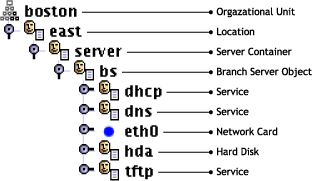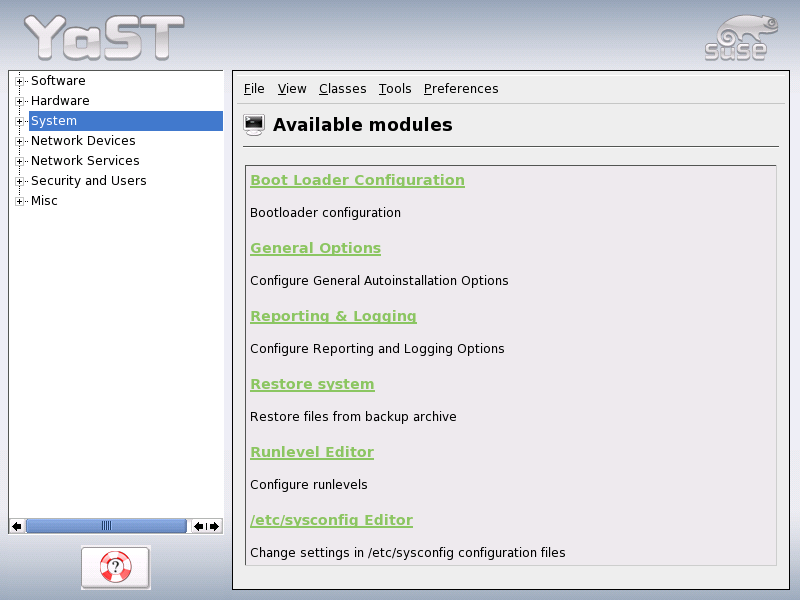10.3 Building an Automatic Branch Server Installation Image
In the two-tiered administration server and branch server architecture, the branch servers are assumed to be in a remote environment, sometimes far from knowledgeable Linux administrators. To simplify this task, a toolkit is provided that enables administrators to create autoinstall media to automatically install and set up branch servers with very little on-site effort.
This functionality is provided through AutoYaST. AutoYaST provides an automatic installation option that allows new branches to be set up at minimal expense. Novell Linux Point of Service provides an AutoYaST control file for the basic setup and the description files are generated from the LDAP directory. The resulting ISO file must then be burned to a CD for deployment at the Branch Server site.
NOTE:Automatic Branch Server images are created only in ISO format; therefore, CD is the only supported media.
To build an Automatic Branch Server Installation image, you must complete the following steps:
These steps are discussed in the following sections.
10.3.1 Preparing the Administration Server
Before you can create the Automatic Branch Server installation image, you must complete the following:
- Install ImageBuilder. For more information, see Section 8.3.1, Installing ImageBuilder and Image Templates.
- Copy the SLES image source files from the Novell Linux Point of Service CDs to a central distribution directory. For more information, see Section 7.3.1, Copying the Novell Linux Point of Service CDs.
- Define the AdminServer.conf.sles file. This file is automatically generated when you create AdminServer.conf. For more information, see Section 7.3.4, Generating AdminServer.conf or Distribution.xml.
- Provide access to a CD writer to create the boot
media.
NOTE:The CD writer does not need to be installed on the administration server if the CD images can be transferred through the network to a machine equipped with a CD recorder.
10.3.2 Creating the Branch Server Definition in the LDAP Directory
To enable the autoinstall system to configure the branch server, detailed information about the hard disk and the network interfaces must be defined in the LDAP directory. Figure 10-1 represents the LDAP objects required to define the structure for a Branch Server.
Figure 10-1 LDAP objects required for Branch Server definition

reviews the attributes for each LDAP object required to provide the Branch Server definition. For more information about the LDAP directory, refer to Section 5.0, The Novell Linux Point of Service LDAP Directory.
Table 10-2 LDAP objects and attributes for defining a Branch Server
|
LDAP Object |
Required Attributes |
|---|---|
|
scLocation |
The scLocation object defines general information about the Branch Server network. Required attributes include the following:
For information on adding this object class to the LDAP directory, see Section 6.3.2, Adding an scLocation Object. |
|
scServerContainer |
The scServerContainer object is a container for the Branch Server definition. The only required attribute for this container object is the cn. For information on adding this object class to the LDAP directory, see Section 6.3.3, Adding an scServerContainer and scBranchServer Object. |
|
scBranchServer |
The scBranchServer object is a container for the hardware objects that provide the Branch Server definition. The only required attribute for this container object is the cn. For information on adding this object class to the LDAP directory, see Section 6.3.3, Adding an scServerContainer and scBranchServer Object. |
|
scNetworkcard |
The scNetworkCard object provides the configuration for a Branch Server network interface card. Required attributes include the following:
For example, the following posAdmin command creates a sample scNetworkcard object for a Branch Server: posAdmin.pl --user cn=admin,o=mycorp,c=us --password secret --base cn=bs,cn=server,cn=Lab,ou=solutions, o=mycorp,c=us --add --scNetworkcard --scDevice eth2 --ipHostNumber 192.168.1.150 --ipNetmaskNumber 255.255.248.0 --scModul e100 |
|
scHarddisk |
The scHarddisk object provides the configuration for the Branch Server's boot hard disk. Required attributes include the following:
The partitioning scheme for the Branch Server hard disk is the same as Point of Service terminals. Partitions are specified as ‘size type mount point', where size is specified in megabytes, the type is either L for Linux file systems or S for swap space, and the mount point specifies where in the file system hierarchy the partition is mounted. The wildcard “x” must appear as a mount point for swap space partitions and can be used to automatically compute the size of the file system as follows:
Partition entries are separated with a semicolon (;}. For a simple branch server, the partition table x S x;x L / is suggested, which creates swap space and one large root file system. For example, the following posAdmin command creates a sample scHarddisk object for a Branch Server: posAdmin.pl --user cn=admin,o=mycorp,c=us --password secret --base cn=bs,cn=server,cn=Lab,ou=solutions, o=mycorp,c=us --add --scHarddisk --cn sda --scDevice dev/sda --scHdSize 40960 --scPartitionsTable 'x S x;x L /' |
|
scService |
The scService object defines Branch Server services. This can include DNS, DHCP, FTFP, NTP, and RSYNC. Required attributes include the following:
NOTE:High availability services (scHAServices) are not supported for Automatic Branch Server Installation. For information on adding this object class to the LDAP directory, see Section 6.3.3, Adding an scServerContainer and scBranchServer Object. |
For more information about using posAdmin to create LDAP objects, see Section 6.0, Using posAdmin to Manage the LDAP Directory.
10.3.3 Modifying the Branch Server Configuration Template (template.xml)
The default Branch Server configuration is defined in the XML template file, /opt/SLES/POS/xml/template.xml. The DTD (document type definition) which defines the template document’s structure is found in /usr/share/YaST2/include/autoinstall/profile.dtd.
NOTE:As with the Image Specification and Distribution Source Documents, this template can be defined in an XML editor or in a standard text editor. However, it is strongly recommended that you modify the document only with the AutoYaST GUI system. The procedure to modify the Automatic Branch Server Installation template in this section is documented using the AutoYaST GUI system.
To modify the template.xml document using the AutoYaST system:
-
Start YaST with the yast2 autoyast command to display the YaST configuration management system.
Figure 10-2 AutoYaST configuration management system

-
Use to set the profile repository to the template file directory (/opt/SLES/POS/xml/).
-
Click > and select the template file (opt/SLES/POS/xml/template.xml).
Modify the sections of the template.
You can change time zone, add software packages, and change system parameters.
A menu system similar to the YaST configuration interface allows you to modify specific sections of the template.
-
After the XML template has been modified with AutoYaST, remove the DOCTYPE entry because it cannot be parsed correctly by the XSLT processor that is used to transform the file.
To perform this operation, run the following command to clean the template file:
xmllint --dropdtd template-yast2.xml > template.xml
10.3.4 Generating the Automatic Branch Server Installation Image
The posldap2autoinstcd.pl script is used to create the Automatic Branch Server Installation images. It generates an ISO file (autoinst.iso) and an XML document (autoinst.xml). This utility is located in the /usr/sbin directory.
The basic command line required to generate the Automatic Branch Server Installation images is:
posldap2autoinstcd.pl [options]
Table 10-3 summarizes the posldap2autoinstcd command options.
Table 10-3 posldap2autoinstcd command options
|
Option |
|
Description |
|---|---|---|
|
--DN branchserverdn |
Defines the Branch Server distinguished name (DN). posldap2autoinstcd.pl uses the DN of the branch server to create the following:
This parameter is required. |
|
|
[--user ldapuser] |
Defines the user account the Branch Server uses to connect to the LDAP directory on the Administration Server. This parameter is optional. If it is not defined, the Branch Server uses the admin account and password created by the posInitLdap.sh or posInitEdir.sh script during the initial configuration of the Administration Server. |
|
|
[--pasword ldap_password] |
Defines the password the Branch Server uses to connect to the LDAP directory on the Administration Server. This parameter is optional. If it is not defined, the Branch Server uses the admin account and password created by the posInitLdap.sh or posInitEdir.sh script during the initial configuration of the Administration Server. |
|
|
[--SLES distribution_ directory] |
Defines the path to the distribution directory where the SLES RPMs required to build the Automatic Branch Server Installation image are located. This parameter is optional. If it is not defined, posldap2autoinstcd.pl uses the default distribution directory, /opt/SLES/POS/dist/. |
|
|
[--SP directory] |
Specifies the directory where an SLRS or SLES service pack is available.This option is used to integrate a service pack into the boot or installation system. This parameter is optional. If it is not defined, posldap2autoinstcd.pl uses only the SLES RPM packages specified in the AdminServer.conf file or the Distribution.xml document. For more information on these files, see Section 8.2.2, AdminServer.conf or Section 9.2.3, Distribution Source Document (Distribution.xml). |
|
|
[--output directory] |
Defines the directory where the Automatic Branch Server Installation images-autoinst.iso and autoinst.xml-are created. This parameter is optional. If it is not defined, the images are created in the directory where posldap2autoinstcd.pl is executed. |
|
|
[--tmp directory] |
Defines the temp directory posldap2autoinstcd.pl uses directory for temporary files. The default is /tmp/. |
|
|
[--xml document] |
Defines the name of the Automatic Branch Server Installation XML document produced in the output. This parameter is optional. If it is not defined, the XML document is named autoinst.xml. |
|
|
[--template template] |
Defines the directory where the template file used to create the Automatic Branch Server Installation image is located. This parameter is optional. If it is not defined, posldap2autoinstcd.pl uses the default template, /opt/SLES/POS/xml/template.xml. |
|
The following sample command creates an Automatic Branch Server Installation image:
posldap2autoinstcd.pl --user cn=admin,0=mycorp,c=us --password secret --DN cn=bs,cn=server,cn=branch,ou=boston,o=mycorp,c=us
This image has the following parameters:
- The branch server uses the user account, cn=admin,o=mycorp, c=us, to log in to the LDAP directory. The password for this account is “secret.”
- The Branch Server is associated with scBranchServer object, bs.server.branch.boston.mycorp.us.
10.3.5 Creating the Boot Media
After you generate the Automatic Branch Server Installation images, you must create the CD that will be used to boot and configure the Branch Server.
The build the boot CD, you must complete the following steps:
NOTE:In this example, cdrecord is used to create a CD on a CD recorder. cdrecord is a Linux command line program that is used to record data or audio on a DVD/CD recorder.
-
Use the following command to find your CD recorder device:
cdrecord -scanbus
Linux returns the following information:
cdrecord dev=2,0,0 2,0,0 200) 'PIONEER ' 'DVD-RW DVR-106D' '1.07' Removable CD-ROM
-
Record the Automatic Branch Server Installation ISO image (autoinst.iso) to the CD:
cdrecord dev=2,0,0 autoinst.iso
-
Create a file named “info” to control the AutoYaST process. It must contain the following lines:
install=cd:/// autoyast=floppy:///autoinst.xml autoyast2=floppy:///autoinst.xml
-
Create a file named “posInitBranchserver.auto.cfg” to control the automatic setup of the branch server software. It must contain the following lines:
COMPANYNAME="your_company_name" COUNTRY="country" ADMINSERVER="IP_address" POSADMINDN="dn" PASSWORD="username_password"
If the password should not be set up automatically for security reasons, it can be omitted. In this case, posInitBranchserver.sh requests the password when the Branch Server starts. For more information, see
Setting Up a Branch Server
in the Novell Linux Point of Service 9 Installation Guide. -
Copy the following files to an MS-DOS formatted floppy disk:
- info
- posInitBranchserver.auto.cfg
- autoinst.xml
-
At the Branch Server site, boot the Branch Server by inserting the floppy disk and CD, and then booting the server. Make sure the Branch Server is set to boot from CD.
The automatic installation system starts. It requests confirmation at the start of the installation, but otherwise runs without interaction.
-
After the system is installed, log in as the root user to start the automatic configuration of the branch server software.
The posInitBranchserver.sh script automatically starts, sets the parameters as specified in the posInitBranchserver.auto.cfg file, and requests any missing parameters.
-
Run possyncimages.pl to download the client images from the Administration Server.